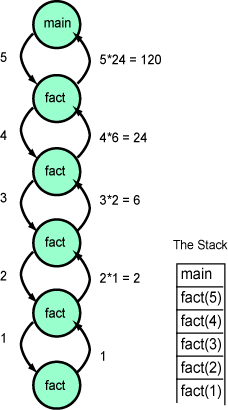fact(5) == 5*fact(4)
== 5*( 4*fact(3) )
== 5*( 4*( 3*fact(2)) )
== 5*( 4*( 3*(2*fact(1))) )
== 5*( 4*( 3*(2*1)) )
== 5*4*3*2*1
== 120

If
the subroutine fact()
is called with an argument
greater than one, it calls itself,
fact(), with a new argument.
This is a new activation of the same code.
This is not a problem because
the data for the first activation of fact()
is on
the stack.
The new activation has a fresh stack frame for its data.
Each activation of fact() gets its own
stack frame which it uses for its own data.
In the diagram,
each activation corresponds to a green circle
which contains the data for that activation.
Each activation works with its own data in
its own stack frame.
The activations do not interfere with each other.
When the first activation gets control again, its data is available at the top of the stack. It also has the value returned from the call it made.
In the code, n is the value in
the stack frame and fact(n-1)
is the value returned by the call it made.
# int fact( int n )
# {
# if ( n <= 1 )
# return 1;
# else
# return n*fact(n-1);
# }
Each bead on the activation chain represents an activation of a subroutine. The label on a downward arc is the argument to an activation. The label on an upward arc is the returned value.
Each bead on the activation chain corresponds to one stack frame.
The picture of the stack shows what it looks like when
the activation fact(1) is running.
The upward arrows have not happened yet.
When the value 120 is returned to main,
only main is active, the stack
contains only its stack frame, and the activation chain consists only of
main.